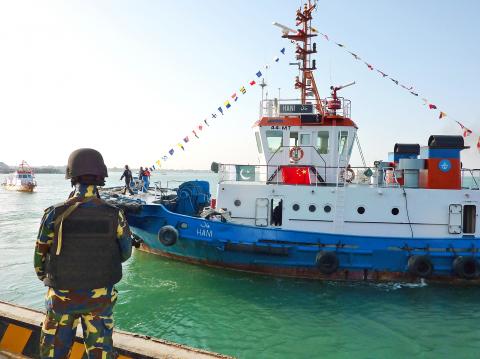Militant commander Hazar Khan gave up his 15-year insurgency in Pakistan’s Balochistan Province last year, and now he hopes for a job with the very government he stood against, as the province prepares for a great leap forward fuelled by Chinese investment.
“We people came because our life has already passed in the mountains and now our children’s lives should be better,” said Khan, who has returned to his old tribal life of farming as he seeks government employment. “Now, nobody from my family is in the mountains; all have surrendered along with me.”
The decision was sweetened by the government’s offer to pay him 300,000 rupees (US$3,000) under a “General Amnesty Scheme” authorities say has convinced hundreds of insurgents to surrender — though he has yet to see the money, Khan said.

Photo: AFP
Balochistan has been wracked for years by Islamist, sectarian and separatist violence that in the past rendered the province virtually a no-go zone for outsiders. The province is Pakistan’s most unstable and underdeveloped province, with the majority of its estimated 8.5 million people living in poverty.
Suppressing the rebellion by force in the desolate province, much of which is desert and mountains, has proven difficult.
However, an ambitious bid by Beijing to gain greater access to the Middle East, Africa and Europe through Pakistan has given new impetus to the push for stability.
The US$46 billion China-Pakistan Economic Corridor (CPEC) is set to culminate in the Baloch fishing port of Gwadar.
With its dusty moonscape and shining new port, officials have repeatedly suggested the city is another Dubai in the making.
Property prices are soaring there and in the provincial capital, Quetta, as Baloch authorities say they have restored peace to the majority of the province.
Small businesses driven from Quetta by violence over the years are also returning, ready to take advantage of increased security and China’s interest.
A decade ago, the security situation was “very bad,” said Nadir Hussain, owner of a printing and publishing house in Quetta, adding that he had considered leaving like his fellow businesspeople.
However, with increased stability, “people have come back and started small businesses, opened small shops... It is improving, slowly,” he said. “We have restored peace in 95 percent of Balochistan,” Balochistan Home Secretary Akbar Durrani said.
About 600 insurgents have surrendered since the government began offering the compensation package last year, he said: 1.5 million rupees to commanders, 1 million rupees to their deputies, and 500,000 rupees to foot soldiers.
However, the scheme could backfire.
“The authorities are not paying the promised compensation of 500,000 rupees,” said Nawab Changez Marri, chief of the Marri tribe and provincial irrigation minister.
“They are paying them only 100,000 rupees and then leave them on their own without even ensuring security,” he said, adding that in some cases, insurgents have killed the families of those who surrendered.
Marri said he had helped persuade many militants to surrender — but that the failures have seen others who were ready to lay down their arms change their minds.
Security issues have mired CPEC in the past, with separatist rebels — who oppose Gwadar’s development while the province is not independent — blowing up numerous gas pipelines and trains, and attacking Chinese engineers.
China says it is confident the Pakistani military — which has been repeatedly accused by international rights groups of abuses in Balochistan — is in control of the issue.
“I believe the security situation has improved to a great extent,” Acting Chinese Ambassador to Pakistan Zhao Lijian (趙立堅) told a conference on CPEC in Gwadar last month, crediting the army.
In the long term, ensuring stability and the success of CPEC could depend on the government’s ability to make sure the Baloch population — rather than the establishment in Punjab — benefit, observers say.
Profits will have to be shared with Balochistan — “otherwise we resist,” one senior Baloch leader said on the sidelines of last month’s conference in Gwadar.
Provincial ministers and military leaders at the conference were bombarded with questions from a lively audience concerned that CPEC gains would bypass them.
“Security issues and political differences are casting doubts about [the corridor’s] future,” Mir Muhammad Akbar Mengal, senior vice president of the provincial Chamber of Small Traders and Industries, said in Quetta.
“Its success is local people’s success,” said Atta Muhammad Jaffer, a retired senior government official and a livestock trade.
Mengal said the Baloch have high hopes for the corridor.
“[Success] only depends on the government’s commitment... The people of Balochistan are ready for cooperation,” he said.
Pakistani Prime Minister Nawaz Sharif has formed a committee of provincial chief ministers to address the concerns and officials remain bullish about the Herculean task before them.
“This CPEC project is a fate changer,” Balochistan Provincial Government spokesman Anwaar-ul-Haq Kakar said.

UNCERTAINTIES: Exports surged 34.1% and private investment grew 7.03% to outpace expectations in the first half, although US tariffs could stall momentum The Chung-Hua Institution for Economic Research (CIER, 中華經濟研究院) yesterday raised its GDP growth forecast to 3.05 percent this year on a robust first-half performance, but warned that US tariff threats and external uncertainty could stall momentum in the second half of the year. “The first half proved exceptionally strong, allowing room for optimism,” CIER president Lien Hsien-ming (連賢明) said. “But the growth momentum may slow moving forward due to US tariffs.” The tariff threat poses definite downside risks, although the scale of the impact remains unclear given the unpredictability of US President Donald Trump’s policies, Lien said. Despite the headwinds, Taiwan is likely

When Lika Megreladze was a child, life in her native western Georgian region of Guria revolved around tea. Her mother worked for decades as a scientist at the Soviet Union’s Institute of Tea and Subtropical Crops in the village of Anaseuli, Georgia, perfecting cultivation methods for a Georgian tea industry that supplied the bulk of the vast communist state’s brews. “When I was a child, this was only my mum’s workplace. Only later I realized that it was something big,” she said. Now, the institute lies abandoned. Yellowed papers are strewn around its decaying corridors, and a statue of Soviet founder Vladimir Lenin

UNIFYING OPPOSITION: Numerous companies have registered complaints over the potential levies, bringing together rival automakers in voicing their reservations US President Donald Trump is readying plans for industry-specific tariffs to kick in alongside his country-by-country duties in two weeks, ramping up his push to reshape the US’ standing in the global trading system by penalizing purchases from abroad. Administration officials could release details of Trump’s planned 50 percent duty on copper in the days before they are set to take effect on Friday next week, a person familiar with the matter said. That is the same date Trump’s “reciprocal” levies on products from more than 100 nations are slated to begin. Trump on Tuesday said that he is likely to impose tariffs

READY TO BUY: Shortly after Nvidia announced the approval, Chinese firms scrambled to order the H20 GPUs, which the company must send to the US government for approval Nvidia Corp chief executive officer Jensen Huang (黃仁勳) late on Monday said the technology giant has won approval from US President Donald Trump’s administration to sell its advanced H20 graphics processing units (GPUs) used to develop artificial intelligence (AI) to China. The news came in a company blog post late on Monday and Huang also spoke about the coup on China’s state-run China Global Television Network in remarks shown on X. “The US government has assured Nvidia that licenses will be granted, and Nvidia hopes to start deliveries soon,” the post said. “Today, I’m announcing that the US government has approved for us